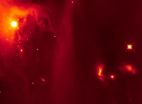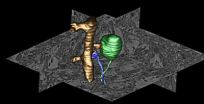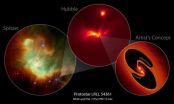(Press-News.org) The 11 March 2011 Tohoku-Oki earthquake (Mw9.0) produced the largest slip ever recorded in an earthquake, over 50 meters. Such huge fault movement on the shallow portion of the megathrust boundary came as a surprise to seismologists because this portion of the subduction zone was not thought to be accumulating stress prior to the earthquake. In a recently published study, scientists from the Integrated Ocean Drilling Program (IODP) shed light on the stress state on the fault that controls the very large slip. The unexpectedly large fault displacements resulted in the devastating tsunamis that caused tremendous damage and loss of lives along the coast of Japan. The study, published in 8 February 2013 issue of the journal Science, presents compelling evidence that large slips are the results of a complete stress drop during the earthquake. These new findings from IODP Japan Trench Fast Drilling Project (JFAST) research are relevant to better understanding earthquakes and tsunamis in many areas of the world.
"The study investigated the stress change associated with the 2011 Tohoku-Oki earthquake and tested the hypothesis by determining the in-situ stress state of the frontal prism from the drilled holes," says a lead author Weiren Lin of Japan Agency for Marine-Earth Science and Technology (JAMSTEC). "We have established a new framework that the large slips in this region are an indication of coseismic fault zone and nearly the total stress accumulated was released during the earthquake."
JFAST was designed and undertaken by the international scientific community to better understand the 2011 Tohoku-oki earthquake. The expedition was carried out aboard the scientific drilling vessel Chikyu from April to July 2012. JFAST drill sites were located approximately 220 km from the eastern coast of Honshu, Japan, in nearly 7000 m of water.
"The project is looking at the stress and physical properties of the fault zone soon after a large earthquake," co-author James Mori of Kyoto University, Co-Chief Scientist who led the JFAST expedition explains.
It is the first time that "rapid-response drilling" (within 13 months after the earthquake) has been attempted to measure the temperature across a subduction fault zone. The fast mobilization is necessary to observe time sensitive data, such as the temperature signal. JAMSTEC successfully mobilized a research expedition for IODP to investigate the large displacement by drilling from the ocean floor to the plate boundary, reaching a maximum depth of more than 850 m below seafloor (mbsf).
"Understanding the stress conditions that control the very large slip of this shallow portion of the megathrust may be the most important seismological issue for this earthquake." Mori says.
The research published this week determined the stress field from breakouts observed in a borehole around 820 mbsf, in a region thought to contain the main slip zone of the 2011 earthquake. Lin and his co-authors analyzed a suite of borehole-logging data collected while drilling with Logging-While-Drilling (LWD) tools during IODP Expedition 343. Local compressive failures (borehole breakouts) are formed in the borehole wall during the drilling and are imaged with the LWD tools. The orientation and size of the breakouts are used to infer the present direction and magnitudes of the stress field. An important finding of the paper is that the present shear stress on the fault is nearly zero, indicating that there was a nearly complete stress change during the earthquake. Usually, earthquakes are thought to release only a portion of the stress on the fault.
"This was the first time for such nearly complete stress change has been recognized by direct measurement in drilling through the ruptured fault. This is the first time direct stress measurements have been reported, a little over a year after a great subduction zone earthquake." Lin says.
The expedition set new milestones in scientific ocean drilling by drilling a borehole to 854.81 mbsf in water depths of 6897.5 meters. Deep core was obtained and analyzed from this depth. The Japan Trench plate boundary was sampled and a parallel borehole was instrumented with a borehole observatory system. The core samples and borehole observatory provide scientists with valuable opportunities to learn about residual heat, coseismic frictional stress, fluid and rock properties, and other factors related to megathrust earthquakes.
"We will be able to address very fundamental and important questions about the physics of slip of the thrust near the trench, and how to identify past events in the rock record." says Frederick Chester, Texas A&M University, co-author of the Science report and the other expedition Co-Chief Scientist.
The expedition science party, comprising both ship-board and shore-based scientists, is conducting further investigations of core samples and borehole logging data. Data from the borehole observatory are expected to be retrieved later this month using the JAMSTEC ROV Kaiko7000II, and those data will be combined with the current results to continue to increase understanding of the processes involved in this large slip earthquake.
"We anticipate that the results from the JFAST expedition will provide us with a better understanding of the faulting mechanisms for this critical location," says Mori. "Investigations and research findings from the expedition have obvious consequences for evaluating future tsunami hazards at other subduction zones around the world, such as the Nankai Trough in Japan and Cascadia in the Pacific of North America."
###
ABOUT IODP:
The current scientific ocean drilling program, the Integrated Ocean Drilling Program (IODP), is an international research program dedicated to advancing scientific understanding of the Earth through drilling, coring, and monitoring the subseafloor. The JOIDES Resolution is a scientific research vessel managed by the US Implementing Organization of IODP (USIO). Chikyu is a scientific drilling vessel operated by JAMSTEC/CDEX (Japan), and mission-specific platforms are supplied by ECORD (the European Consortium for Ocean Research Drilling). IODP is supported by two lead agencies: the US National Science Foundation (NSF) and Japan's Ministry of Education, Culture, Sports, Science and Technology (MEXT). Additional program support comes from ECORD, the Australian-New Zealand IODP Consortium (ANZIC), India's Ministry of Earth Sciences, the People's Republic of China (Ministry of Science and Technology), the Korea Institute of Geoscience and Mineral Resources, and Coordination for Improvement of Higher Education Personnel (CAPES) in Brazil.
USEFUL WEBSITES:
For more information about JFAST project, latest images and blogs from the expedition, visit
www.jamstec.go.jp/chikyu/exp343/.
For more information about IODP, visit www.iodp.org/.
CONTACTS:
About the JFAST Project
James Mori
Professor, Earthquake Hazards Division, Disaster Prevention Research Institute, Kyoto University, Kyoto, Japan,
mori@eqh.dpri.kyoto-u.ac.jp
+81-774-38-4205
Frederick Chester
Professor, Center for Tectonophysics, Department of Geology and Geophysics, Texas A&M University, College Station, Texas, U.S.,
chesterf@tamu.edu
+1-979-845-3296
About the Findings in Science
Weiren Lin
Principal Research Scientist, Physical Property Research Group, Kochi Institute for Core Sample Research, Japan Agency for Marine-Earth Science and
Technology (JAMSTEC)
lin@jamstec.go.jp
About IODP
Miyuki Otomo
Outreach and Communications Manager
IODP Management International, Inc. (IODP-MI), Tokyo, Japan
motomo@iodp.org
+81-3-6701-3188 END
New report in Science illuminates stress change during the 2011 Tohoku-Oki earthquake
2013-02-08
ELSE PRESS RELEASES FROM THIS DATE:
Translation error tracked in the brain of dementia patients
2013-02-08
The proteins that have now been identified shouldn't actually exist. Nevertheless, they build the core of cellular aggregates whose identity has been enigmatic until now. These aggregates are typically associated with hereditary neurodegenerative diseases including variants of frontotemporal dementia (FTD), also known as frontotemporal lobar degeneration (FTLD), and amyotrophic lateral sclerosis (ALS). They are likely to be damaging and might be a target for therapy.
FTD and ALS are part of a group of neurodegenerative diseases that show a broad and overlapping variety ...
Stress at work very unlikely to cause cancer
2013-02-08
Work-related stress is not linked to the development of colorectal, lung, breast or prostate cancers, a study published today on bmj.com suggests.
Around 90% of cancers are linked to environmental exposures and whilst some exposures are well recognised (such as UV radiation and tobacco smoke), others are not (psychological factors such as stress).
Stress can cause chronic inflammation which has been shown to have various roles in the development of cancer, plus stressed individuals are more likely to smoke, consume excessive amounts of alcohol and be obese – all ...
43 percent reduction in deaths from paracetamol due to smaller pack sizes
2013-02-08
Research: Long term effect of reduced pack sizes of paracetamol on poisoning deaths and liver transplant activity in England and Wales: interrupted time series analysis
The number of deaths and liver transplants due to paracetamol overdoses has significantly reduced thanks to UK legislation to make pack sizes smaller, a paper published today on bmj.com suggests.
Paracetamol overdoses are a common method of suicide and frequent cause of liver damage. In September 1998, a new legislation was introduced by the UK Government which restricted pack sizes to a maximum of ...
UF researchers include humans in most comprehensive tree of life to date
2013-02-08
GAINESVILLE, Fla. --- An international team of scientists including University of Florida researchers has generated the most comprehensive tree of life to date on placental mammals, which are those bearing live young, including bats, rodents, whales and humans.
Appearing Thursday in the journal Science, the study details how researchers used both genetic and physical traits to reconstruct the common ancestor of placental mammals, the creature that gave rise to many mammals alive today. The data show that contrary to a commonly held theory, the group diversified after ...
New study highlights Chagas disease as a growing health and socio-economic challenge
2013-02-08
WASHINGON, D.C.—February 7, 2013—Today, The Lancet Infectious Diseases published a new report that examines the global economic burden of Chagas disease. In the first study of its kind, researchers measured the health and economic impact of Chagas disease and found that the total economic burden of Chagas disease matches or exceeds that of many more well-known diseases such as rotavirus, Lyme disease and cervical cancer.
Chagas disease infects an estimated 10 million people worldwide, with most cases occurring in Latin America. It is a parasitic infection transmitted ...
For drug makers, new 3-D control opens wealth of options
2013-02-08
New Haven, Conn.— A team of scientists anchored at Yale University has demonstrated a new, highly versatile approach for quickly assembling drug-like compounds, establishing a broad new route to drug discovery and medical treatment. They report their results in the journal Science on Feb 8.
Drug molecules interact with their targets, such as proteins or enzymes, by attaching to them in a way that neutralizes the target's undesirable effects in the body. This is sometimes called the "lock-and-key" method. The new approach offers scientists far greater control over the ...
Hubble captures strobe flashes from a young star
2013-02-08
The cause of the fireworks seen in this Hubble image and video is hidden behind a dense disc and envelope of dust. However, astronomers think that the strobe effect is due to periodic interactions between two newly-formed stars that are gravitationally bound to each other.
These two stars drag material inwards from a surrounding disc of gas and dust. Astronomers propose that the light flashes seen in this video are due to this material suddenly being dumped onto the growing stars as they near one another in their orbits, unleashing a blast of radiation.
"The protostar ...
Hastings Center resources chart progress in debate over medical research with animals
2013-02-08
The scientific and ethical debate over the use of animals in medical research has raged for years, but perspectives are shifting, viewpoints are becoming more nuanced, and new initiatives are seeking alternatives to animal testing, according to a special report by The Hastings Center, "Animal Research Ethics: Evolving Views and Practices." The report is available on a new Web site, animalresearch.thehastingscenter.org, a hub of educational information that defines and interprets this changing landscape.
These resources are the outcome of a project on the ethics of medical ...
Excess protein linked to development of Parkinson's disease
2013-02-08
Researchers at the University of California, San Diego School of Medicine say overexpression of a protein called alpha-synuclein appears to disrupt vital recycling processes in neurons, starting with the terminal extensions of neurons and working its way back to the cells' center, with the potential consequence of progressive degeneration and eventual cell death.
The findings, published in the February 6, 2013 issue of the Journal of Neuroscience, have major implications for more fully understanding the causes and mechanisms of Parkinson's disease (PD), a neurodegenerative ...
NASA telescopes discover strobe-like flashes in a suspected binary protostar
2013-02-08
VIDEO:
This video, created from a sequence of images from the Hubble Space Telescope, shows a pulse of light emanating from the protostellar object LRLL 54361. Most if not all of...
Click here for more information.
Two of NASA's great observatories, the Spitzer and Hubble space telescopes, have teamed up to uncover a mysterious infant star that behaves like a strobe light.
Every 25.34 days, the object, designated LRLL 54361, unleashes a burst of light. Although a similar ...


